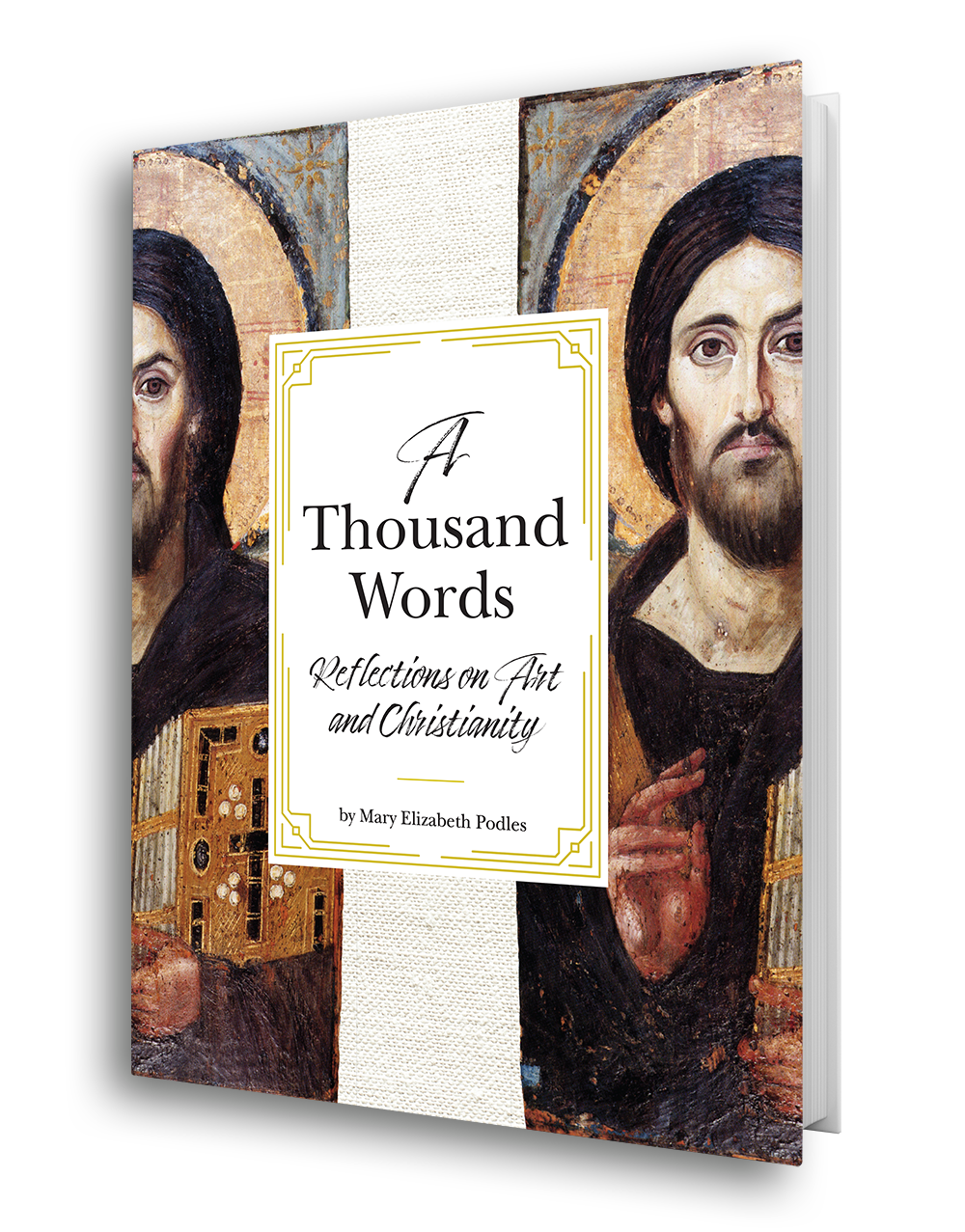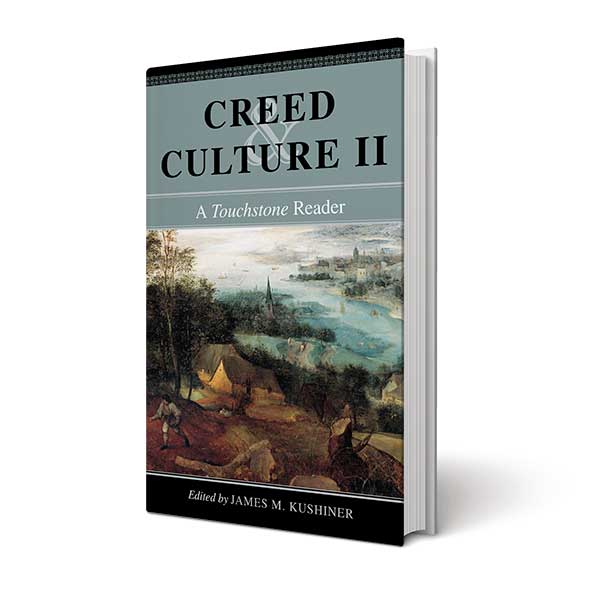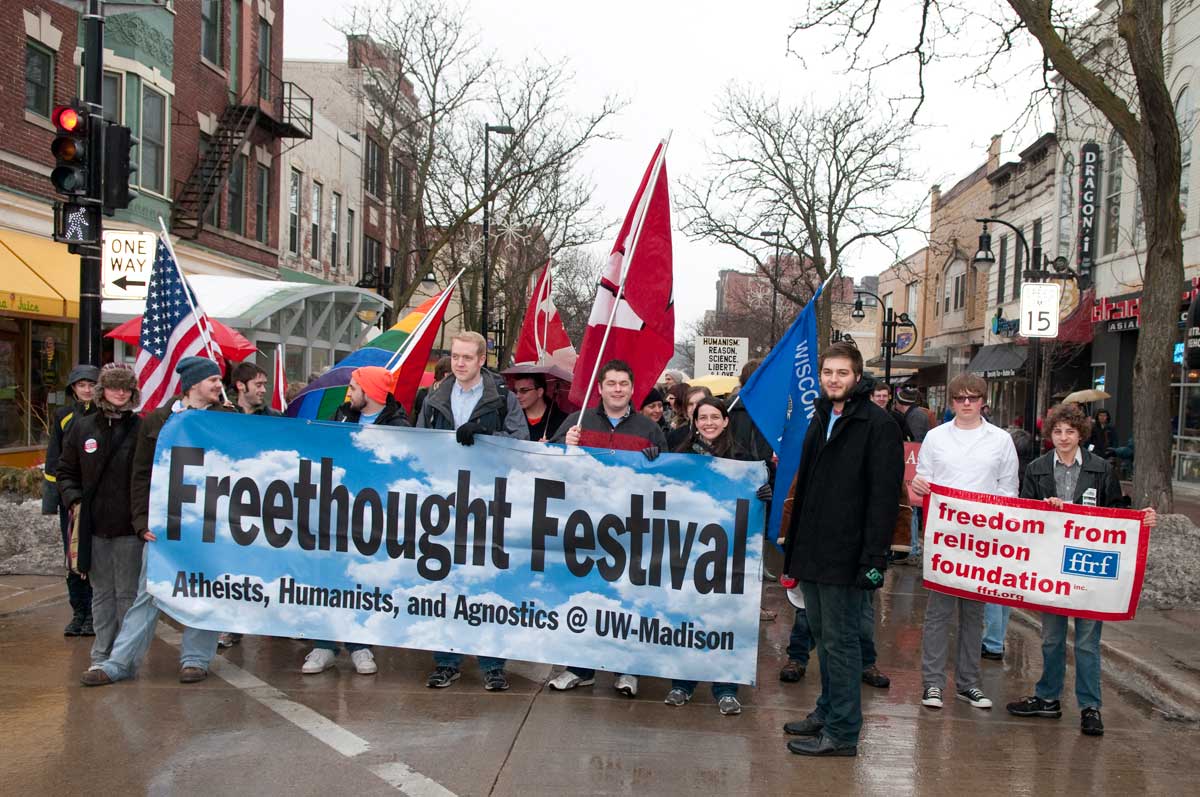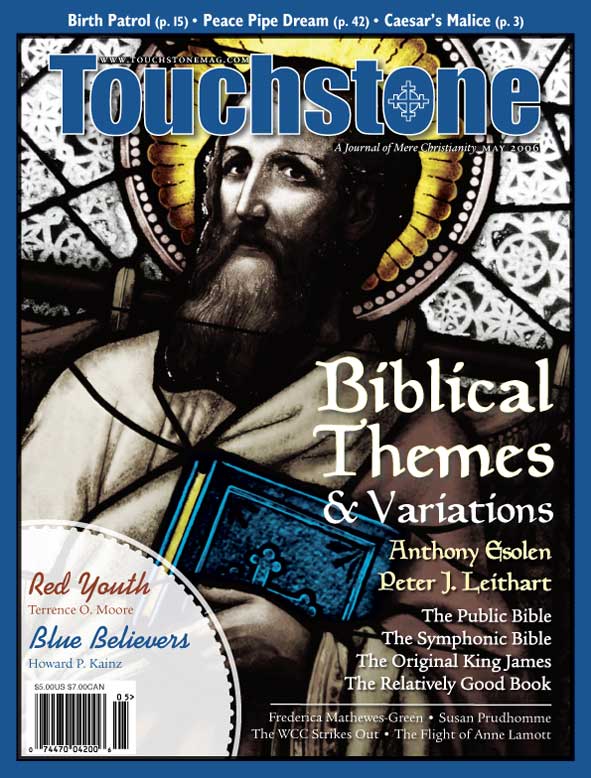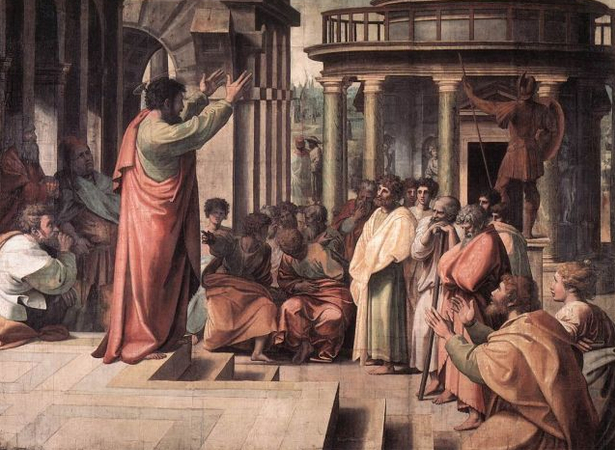Liberalism as Religion
The Culture War Is Between Religious Believers on Both Sides
by Howard P. Kainz
Many Christians view the “culture war” as a clash between religious believers and secularist “liberals.” But there are liberals . . . and there are liberals. Most of the heat of battle occurs where traditional religious believers clash with certain liberals who are religiously committed to secular liberalism.
This explains why talking about abortion or same-sex “marriage,” for example, with certain liberals is usually futile. It is like trying to persuade a committed Muslim to accept Christ. Because his religion forbids it, he can only do so by converting from Islam to Christianity; he cannot accept Christ as long as he remains firmly committed to Islam. So it is with firmly committed liberals: Their “religion” forbids any concessions to the “conservative” agenda, and as long as they remain committed to their secular ideology, it is futile to hope for such concessions from them.
But can a secular ideology fairly be classified as a religion?
The Ideal Religion
Religion in the most common and usual sense connotes dedication to a supreme being or beings. While one’s gods may be demonic, as in Satanic religions, or may be deified humans rather than of an order beyond the human, as in the ancient Roman religions that deified the Caesars—they are understood to be personal beings.
But, especially in the last few centuries, “religion” has taken on the additional connotations of dedication to abstract principles or ideals rather than a personal being. The French Enlightenment, with its worship of Reason, is a prime example of this kind of religion. The god is no longer personal, but abstract, though it may be personified in art or ritual (as, for example, when the actress Mademoiselle Maillard, representing the Goddess of Reason, was enthroned with great festivity in the Cathedral of Notre Dame in 1793).
Hence, modern dictionaries include definitions relating religion to impersonal principles rather than persons. The Merriam-Webster Collegiate Dictionary widens the definition to include: “a cause, principle, or system of beliefs held with ardor and faith.” So in our day, Scientology is considered a religion, and even an atheist could say proudly, “Humanism is my religion.”
Meaning religion in only this broad, even purely metaphorical sense, the atheist may bristle at the notion that his “religion” entails anything other that adherence to his core principles, whatever they may be. Yet two movements of the last century, one explicitly atheist and the other vehemently secular if not outright atheist, exhibit many elements strikingly similar to those of more traditional religions.
Marxism as Religion
Until recently, the most notable example of a secular movement that was, for all practical purposes, a religion, was Marxism. During the global expansion of Marxism in the twentieth century, many critics noted its religious and quasi-religious characteristics (see, for instance, chapter XVI, “The Emergence of the Secular Kingdom of God,” in my Democracy and the “Kingdom of God”).
For example, Marxism had dogmas, core teachings that all Marxists embraced. Among these were “economic determinism,” the doctrine that politics, culture, and ethics were necessary extensions of economic relations; and the “dictatorship of the proletariat,” a necessary historical stage in the inevitable transformation of capitalism into socialism. Such dogmas were laid out in Marxism’s canonical scriptures, which included Das Kapital, The Communist Manifesto, The Little Red Book of Mao Tse Tung, and other official Marxist-Leninist works of the mid-twentieth century.
Marxist orthodoxy was safeguarded by its priests and theologians, who taught the requisite dogmas and presided over the ritualistic observances, principally workers’ strikes, especially general strikes . Throughout Marxist regimes, ideological police and government censors saw that the dogmas found their way into factories and neighborhood organizations and newspapers. Local communes functioned like parochial congregations, and vied with one another for fidelity to socialism, while the ideal of the Third International replaced the Christian image of the Church Militant. In academe, philosophy professors studiously promoted adherence to dialectical materialism (“Diamat”) as the common creed.
Deviations from dogma, i.e., heresies, needed to be suppressed. Things associated with the two great heresies, traditional religion and capitalism, were banned and demonized. Traditional religion, the “opiate of the masses” in Karl Marx’s famous phrase, had to be religiously abolished for the success of scientific socialism. Capitalism, particularly as expressed through private ownership of the means of production, had to be abandoned in favor of the foresight and “five-year plans” of state-controlled hierarchies. Orthodox Marxists had meticulously to avoid such sins as expropriating “surplus value” from an army of oppressed workers, preaching rewards in an afterlife to the proletariat, or settling into the life of a pure consumer removed from the struggles of workers. The wayward were corrected in mandated “reeducation” camps; those found intractable to correction were frequently subjected to excommunication from the party, exile, and even execution.
There was even an eschatology: After the earlier evolutionary stages of capitalism and the dictatorship of the proletariat, the “end times” would come, characterized by a new state of consciousness in “communist man,” who would live in a cooperative, crime-less, international community, without any vestiges of dehumanizing labor; and a hagiography, which included generally accepted revolutionary saints, such as Marx, Engels, and Lenin, as well as some venerated by select or local groups, such as Bakunin and Trotsky.
Liberalism as Religion
Not all Marxists, of course, had sufficient “ardor and faith” to qualify them as “religious” in the wide sense. In the West during the Cold War, there were many persons influenced somewhat by progressive ideals of worker solidarity and a new socialist order, but taking their Marxism with a “grain of salt.” So also now, in the twenty-first century, there are many people working for social justice, human rights, international solidarity, and other causes commonly regarded as liberal without a deep ideological commitment. But there are also those for whom liberalism is a life commitment, held to with the same ardor and faith as Marxism was for its strongest adherents. Among such liberals can be found a cluster of many of the same religious components:
1. Dogmas. The backdrop for the major dogmas of the religiously liberal are those of the eighteenth-century Enlightenment: that mankind must overcome religious superstition by means of Reason; that empirical science can and will eventually answer all the questions about the world and human values that were formerly referred to traditional religion or theology; and that the human race, by constantly invalidating and disregarding hampering traditions, can and will achieve perfectibility.
Contemporary liberalism also includes three ideals selectively borrowed from the New Testament, but with its own suitably revisionist interpretations. The first reinterprets Mark 12:17, Jesus’ admonition to “give to Caesar what is Caesar’s, and to God what is God’s,” as a case for absolute secularism, a wall between church and state, religion reduced to something purely private. Also, whereas the traditional Christian understands Galatians 3:28, “There is neither Jew nor Greek, there is neither slave nor free person, there is neither male nor female,” as extolling the new unity of disparate persons through unity in Christ, the liberal sees it, on the one hand, as wiping away all distinctions between the sexes in a sweeping egalitarianism, and on the other, as wiping away all salient distinctions between cultures (such as their values and morals) in a vapid celebration of “diversity” and “multiculturalism.” Similarly, Matthew 7:1, “Stop judging, that you may not be judged,” no longer conveys the mandate of Jesus to leave the judgment of sinners to God, but instead sweepingly condemns “judgmentalism,” to the extent that one may not even judge whether something is a sin or not.
2. Sins. Yet, ironically, there are sins for the religiously liberal to eschew. In addition to judgmentalism, the most serious sins are racism, which does not simply mean failing to treat members of all races equally, but failing to show special preference for racial minorities; sexism, which does not mean treating members of both sexes with equal dignity, but making any differentiation between male and female roles; and “homophobia,” which does not simply cover unjust discrimination against persons with same-sex desires but also any judgment that such desires are disordered or that acting on them is sinful.
Intolerance is also a grave sin— except as regards Christian fundamentalism and the adherence of Catholics to the teachings of the magisterium. (Islamic fundamentalism, on the other hand, is considered a regrettable but understandable Islamic reaction to the medieval Christian Crusades.) Public ridicule of Catholic dogmas, moral teachings, and the pope, as well as of fundamentalist Protestants are types of scapegoating and exorcism officially allowed by the standard of “political correctness.” Pro-life and pro-family movements can also be demonized as anti-liberal agendas emanating from these Catholic and Protestant religious sources. The vehemence of the denunciations may offer reliable testimony regarding one’s religious commitment to liberalism.
3. Scriptures. The “classical” scriptures of liberalism fall into two categories: Darwinist and scientistic writings championing materialist and naturalistic explanations for everything, including morals; and feminist writings exposing the “evil” of patriarchy and tracing male exploitation of females throughout history up to the present. For trustworthy day-to-day liberal exegesis of ideas and events, The New York Times stands out among newspapers, The Nation among magazines.
4. Priests and Priestesses. The sacerdotal elite are generally intellectuals with a literary or other media flair and an infectious enthusiasm for the liberal agenda. Exemplars include Stephen Jay Gould as a proponent of Darwinist explanations for life and Carl Sagan as a guru defending naturalistic explanations of the universe; Gloria Steinem as a pathfinder for abortion “rights” and other feminist issues; and dissident Catholics such as Garry Wills, Daniel Maguire, and Charles Curran, and their counterparts in certain Protestant denominations, who, as darlings of the liberal media, are always available to excoriate traditional Christian beliefs and morals.
5. Congregations. Over the past several decades, Democratic party leadership has made being pro-abortion a veritable requirement for credibility, and Democratic politicians have vied with one another in asserting their “pro-choice” credentials through such actions as opposing pro-life judicial nominees. Hence, religiously committed liberals gravitate almost exclusively towards the Democratic party for their political affiliation. Other abortion-centered organizations, such as Planned Parenthood, the ACLU, NOW, and the oxymoronic “Catholics for Free Choice,” also help supply a sense of affiliation and commonality for the religiously liberal.
6. Rites and Rituals. The most emphatic statements of liberal religiosity are directed against what is considered to be oppressive sexual morality. Like the ancient pagan mystery rites celebrating unrestrained sensuality in honor of the god Dionysius, “gay pride” parades are held to celebrate liberals’ liberation from traditional sexual morality. Similarly, pro-abortion groups, like ancient Aztecs and Mayans proudly offering child sacrifices to their gods, feel privileged to participate in the ongoing immolation of human fetuses, including female fetuses, to manifest the emancipation of females from childbearing. Through the distribution of condoms, Planned Parenthood literature, and the like, liberals increase their sense of commitment to the feminist cause while preaching it to others.
7. Eschatology. The final goal is not concerned with an afterlife or the “last things,” but a this-worldly, and basically utilitarian, objective—the attainment of the greatest possible happiness by the greatest number here and now. In the estimation of the religiously liberal, all lifestyles and all moralities can approximate this goal, as long as the proscribed illiberal “sins” are avoided.
8. Saints and Martyrs. Margaret Sanger, although somewhat tainted in her day by racism, has been sainted as the founder of Planned Parenthood. Living saints include radical feminists such as Andrea Dworkin, Catharine MacKinnon, and Gloria Steinem, who have supplied spiritual inspiration for sisterhood. Kate Michelman, longtime head of NARAL, and Sarah Weddington, the attorney who won Roe v. Wade, are revered as pathbreakers for abortion “rights.” TV star Ellen De Generes attained reverential status by her courage in “coming out” as a lesbian, and the ordination of the openly homosexual Anglican bishop V. Gene Robinson has been construed as having prophetic significance. Larry Flynt is equally venerated for championing the production and consumption of pornography as a “free speech” issue.
Among the martyrs, Matthew Shepard has lost none of his luster despite the revelation that his 1998 murder was precipitated by a drug dispute rather than the sexual proclivities and practices of the victim. Other liberal martyrs include: (1) pre Roe coathanger-aborted women (estimates of whose deaths have been based on the unreliable figures of Alfred Kinsey, and on the “5,000 to 10,000” deaths a year figure given as testimony by Dr. Bernard Nathanson, who later admitted the figure was fabricated); and (2) those who have been forced to suffer because they live in jurisdictions that have not legalized assisted suicide.
Reasonable Liberals
Of course, religiously committed liberals constitute only a sub-group of contemporary liberals. For many “moderate” liberals, liberalism is a political perspective, not a core ideology. In the culture war it is important for Christians to distinguish between the religiously committed liberal and the moderate liberal. For one thing, Christians should not be surprised when they find no common ground with the former. But they may form occasional, even if temporary, alliances with the latter.
Currently, a moderate liberal may be expected to support human rights, non-discrimination, tolerance, democratization, liberation from political and economic oppression, and similar goals. Even conservatives may identify with such goals, although they may differ in their interpretation of the goals and how best they might be attained. But more important, when specific political and social issues come to the fore, especially controversial ones, moderate liberals will be willing to engage in debate and to consider pros and cons regarding such issues as abortion, same-sex “marriage,” affirmative action, capital punishment, assisted suicide, and so forth.
Religiously committed liberals, on the other hand, like their Marxist counterparts, are characterized by unshakable faith in sanctioned agendas—abortion on demand, with no restrictions or compromises; the abolition of all strictures, standards, and morals regarding consensual sexual behavior; the mainstreaming of same-sex relationships and legitimization of “gay marriage”; the prioritizing of AIDS research and treatment over other medical concerns, while at the same time rejecting morally based preventive measures (e.g., abstinence); knee-jerk refusal to even consider such embarrassing data as the failure rate of condoms, the statistical connection between contraceptive pills and breast cancer, or the often self-serving motivations of family or health providers in supporting assisted suicide. Such issues as these are considered beyond debate by the religiously committed liberal.
In order to maintain purity, religiously committed liberals will adamantly refuse even to consider any ideas or arguments suspected of being conservative. If you present them with books or articles supporting a conservative position, they may thank you politely, but never give any indication of actually reading the material—as if this were a temptation that must be avoided to preserve their integrity. They will carefully avoid cultivating friendships with conservatives, or supporting the nomination or election of conservatives to any positions where they might have some influence. And they will be on the constant lookout for graphic examples of misogynism, homophobia, sexism, and racism among the bêtes noires—Catholics and fundamentalists, as well as prominent conservatives.
It is important that discussions between liberals and conservatives take place, but these are usually only possible with moderate liberals. A conservative can bring up a religiously charged topic with a moderate liberal, with the result that reasonable, multi-sided representations of the topic will be aired in the public square.
But with a religiously committed liberal, calm intellectual debates are rarely possible. For example, the elegant arguments against abortion presented by Hadley Arkes in his 2002 book, Natural Rights and the Right to Choose, will invite thoughtful responses from moderate liberals, but religiously committed liberals will dismiss the arguments unread, considering them on par with the doctrines contained in the tracts handed out by Jehovah’s Witnesses or Mormon missionaries. In other words, their motivation is a faith-commitment, the abjuring of which will necessarily result in personal guilt, infidelity to their spiritual community, and possible ostracism if they prove to be embarrassments to liberal believers.
There are no professional cult-breakers to rescue victims from this recent and already widespread religious movement. It is ironic that those who most strongly denounce fundamentalism should prove to be such fundamentalists themselves. While they may constitute a minority of all contemporary liberals, theirs may be the dominant liberal voice in the public square. Therefore, for the advancement of family and pro-life values, and rational sexual norms, it is important for Christians to be able to distinguish the moderate liberal from his religiously committed counterpart. Among the former, allies may be found; among the latter, only firm opponents. •
New Shrines
Ideologies of all kinds, from Marxism to secular feminism, substitute a normative theory of history for the Judeo-Christian story of salvation and propose this new story as the story of salvation; secular art turns creativity into a religion whose God is so jealous as to make the old demanding God of Judaism, Christianity, and Islam [sic] appear lax; secular moralists demand a doctrinal orthodoxy (political correctness) which religious fundamentalists can only envy; secular moral zealots continue to find no end of causes that call for religious martyrdom; positive thinking and pedagogues of excellence propose a new religious hope; the cults of physical health, replete with ever more demanding forms of asceticism, replace old spiritualities regarding the soul; ancient animism, the worship of nature, takes on new religious forms; myths and fairy tales replace the old Bible stories; new shrines (from Graceland to Lady Diana's tomb) continue to appear; and secular forms of canonization, of books and people, do what religious canonization formerly did. Religion is never at the margins. Everyone has a spirituality, including today's adult children of the Enlightenment.
—Ronald Rolhauser
From his book, The Holy Longing (Doubleday, 1999)
Howard P. Kainz is Professor Emeritus of Philosophy at Marquette University and the author of Democracy East and West (St. Martin's Press, 1984), Democracy and the "Kingdom of God" (Marquette University, 1995), and Politically Incorrect Dialogues (Rodopi, 1999). His Natural Law: An Introduction and Reexamination was published by Open Court in October 2004.
subscription options
Order
Print/Online Subscription
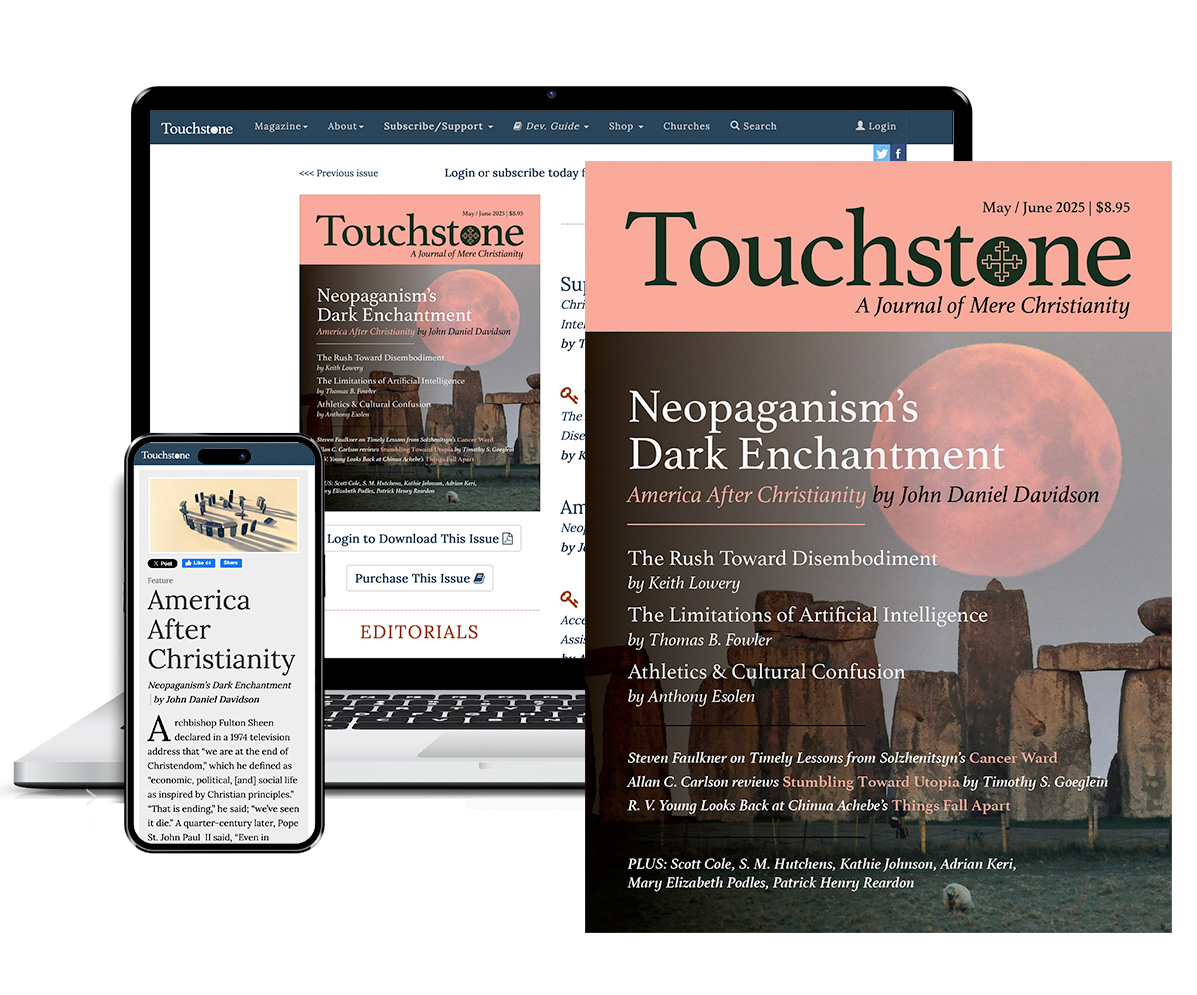
Get six issues (one year) of Touchstone PLUS full online access including pdf downloads for only $39.95. That's only $3.34 per month!
Order
Online Only
Subscription
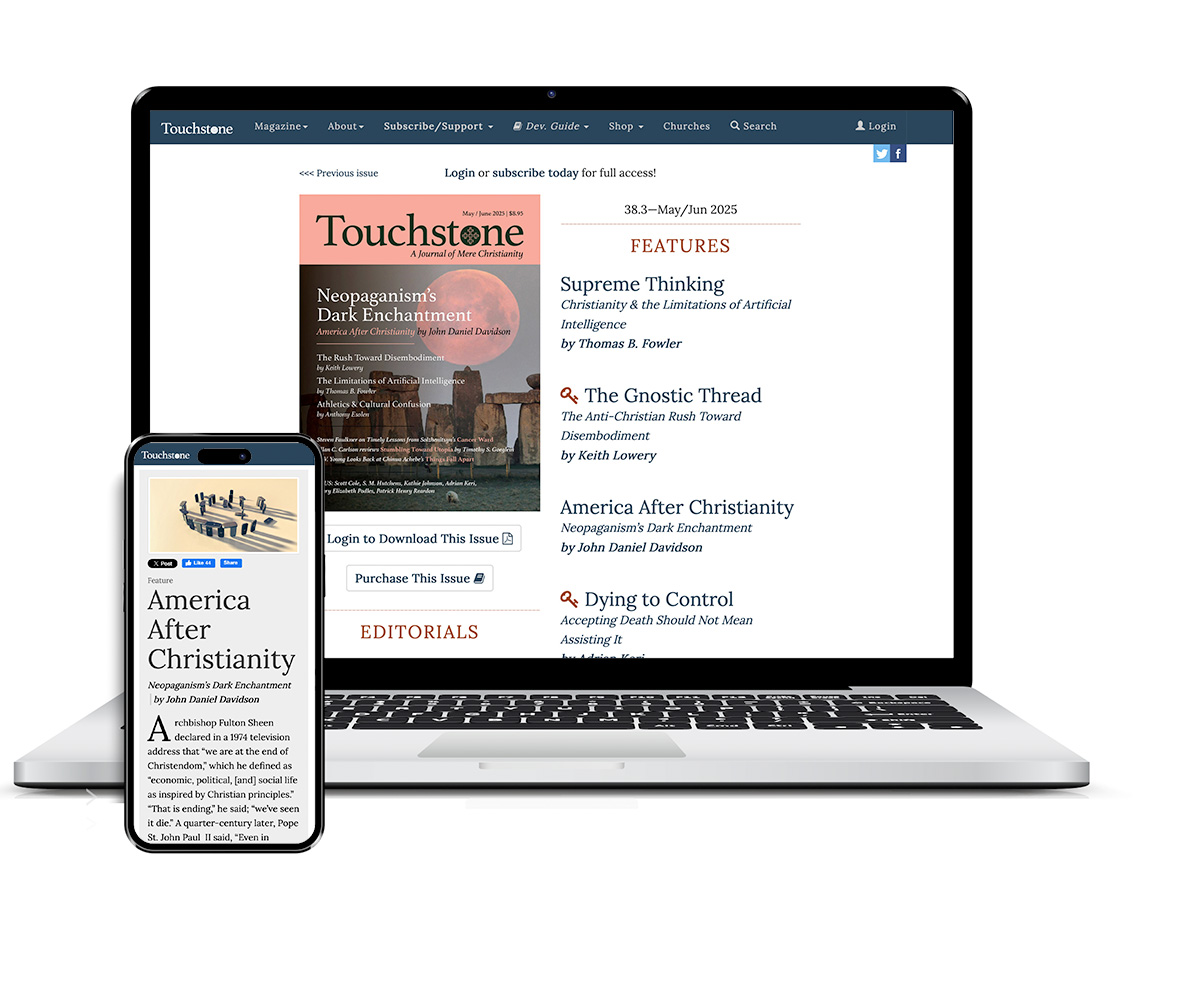
Get a one-year full-access subscription to the Touchstone online archives for only $19.95. That's only $1.66 per month!
bulk subscriptions
Order Touchstone subscriptions in bulk and save $10 per sub! Each subscription includes 6 issues of Touchstone plus full online access to touchstonemag.com—including archives, videos, and pdf downloads of recent issues for only $29.95 each! Great for churches or study groups.
Transactions will be processed on a secure server.
more on culture from the online archives
more from the online archives
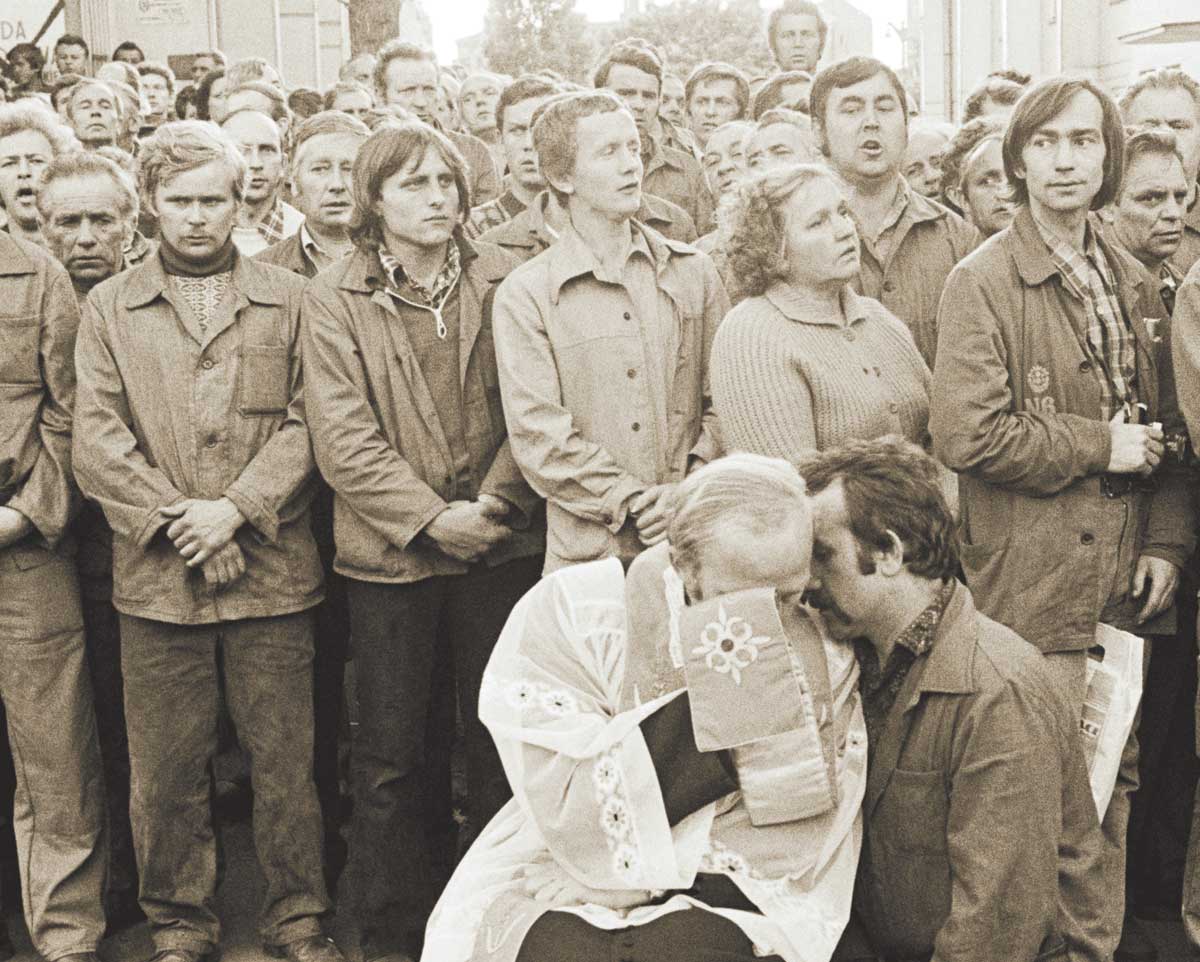
19.10—December 2006
Workers of Another World United
A Personal Commemoration of Poland’s Solidarity 25 Years Later by John Harmon McElroy
calling all readers
Please Donate
"There are magazines worth reading but few worth saving . . . Touchstone is just such a magazine."
—Alice von Hildebrand
"Here we do not concede one square millimeter of territory to falsehood, folly, contemporary sentimentality, or fashion. We speak the truth, and let God be our judge. . . . Touchstone is the one committedly Christian conservative journal."
—Anthony Esolen, Touchstone senior editor



